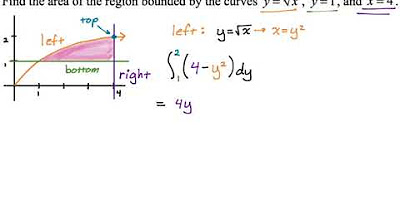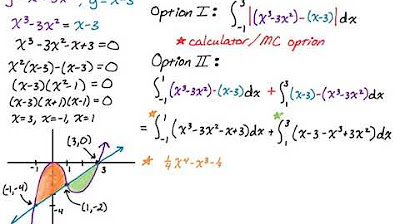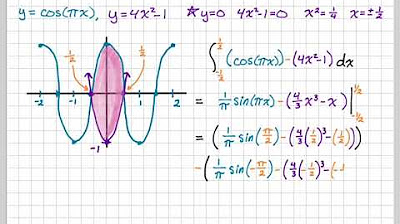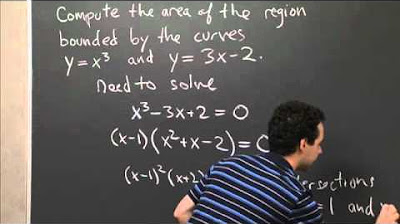Area Between Curves: Integrating with Respect to y (Example 1)
TLDRIn this educational video, the presenter guides viewers through the process of using calculus to calculate the area between curves, specifically focusing on the region in Quadrant 1 bounded by the parabola x=2y^2, the lines y=1 and y=3, and the y-axis. The video emphasizes the importance of sketching the region to understand the problem visually before proceeding with the mathematical solution. The presenter demonstrates the setup of the integral with respect to dy, identifying the bounds of integration as y=1 to y=3, and the curves as the right curve (2y^2) and the left curve (x=0, which simplifies to 0). The integral is then solved using the power rule and evaluated between the given bounds, resulting in an area of 50 2/3 square units. The video concludes with an encouragement for viewers to apply these methods to other problems and offers further assistance in upcoming videos.
Takeaways
- 📐 **Sketch the Region**: Start by sketching the region bounded by the curves and lines to understand the problem visually.
- 🔍 **Identify Bounds**: Determine the left, right, bottom, and top bounds of the region for integration.
- 🧮 **Choose Integration Variable**: Decide to integrate with respect to dy (y-axis) since it simplifies the process.
- ✅ **Set Up the Integral**: Integrate from the bottom to the top bound, subtracting the left curve from the right curve.
- 🚫 **Simplify the Expression**: The left curve is the y-axis (x=0), which simplifies the integral to just the right curve.
- 📈 **Graph the Parabola**: Recognize that x=2y^2 is a parabola on its side, which helps in visualizing the region.
- 🔢 **Perform the Integration**: Use the power rule in reverse to integrate 2y^2 with respect to y.
- 🔄 **Evaluate the Bounds**: Substitute the upper and lower bounds into the integrated expression to find the definite integral's value.
- 📉 **Factor Out Constants**: Factor out constants like 2/3 from the integral to simplify the calculation.
- 🔢 **Calculate the Final Area**: After evaluating the integral, the area of the region is found to be 50 2/3 square units.
- 📚 **Understand the Process**: The video emphasizes the importance of understanding the steps in setting up and solving the integral.
- 🔜 **More Examples to Come**: The presenter indicates there will be more examples in future videos to further illustrate the process.
Q & A
What is the main topic of the video?
-The main topic of the video is using calculus to find the area between curves, specifically between the parabola x = 2y^2 and the lines y = 1 and y = 3 in quadrant one.
Why is it important to sketch the region when solving these types of problems?
-Sketching the region helps to visualize the area you are working with and understand the boundaries of the integral, which is crucial for setting up the correct integral to solve for the area.
What are the four boundaries that need to be identified when sketching the region?
-The four boundaries that need to be identified are the left, right, bottom, and top of the region.
How does the parabola x = 2y^2 relate to the problem?
-The parabola x = 2y^2 is one of the curves that defines the region whose area is to be found. It is the right boundary of the region in this problem.
What is the equation of the left boundary of the region?
-The left boundary of the region is the y-axis, which has the equation x = 0.
What is the method used to solve for the area in the video?
-The method used to solve for the area is integration with respect to y (dy), from the bottom to the top of the region.
What are the limits of integration for the problem?
-The limits of integration are from y = 1 to y = 3.
How does the video simplify the integral to be solved?
-The video simplifies the integral by subtracting the left curve (x = 0) from the right curve (x = 2y^2) and then applying the power rule for integration.
What is the final result for the area of the region?
-The final result for the area of the region is 50 2/3 square units.
Why is it necessary to factor out constants when integrating?
-Factoring out constants simplifies the integration process and makes it easier to apply the limits of integration and evaluate the definite integral.
What does the video suggest for the next step after finding the area?
-The video suggests that there will be another video to work on another example, implying that practice and additional examples are important for understanding the concept.
How does the video ensure the integral is set up correctly?
-The video ensures the integral is set up correctly by identifying the correct boundaries of the region and using the appropriate limits of integration.
Outlines
📐 Calculus Application: Finding Area Between Curves
This paragraph introduces the topic of using calculus to calculate the area between curves, specifically focusing on the dy method. The problem at hand involves finding the area in Quadrant 1 bounded by the parabola x=2y^2, the lines y=1 and y=3. The speaker emphasizes the importance of sketching the region for a better understanding, even if it's not perfectly accurate. The region is defined by the left side (y-axis, x=0), right side (parabola), bottom (y=1), and top (y=3). The integral setup involves integrating from the bottom to the top, using the right curve (2y^2) minus the left curve (y-axis, considered as 0 for this context). The integral is then simplified and solved, resulting in the area being 50 2/3 square units.
Mindmap
Keywords
💡Calculus
💡Area between curves
💡Quadrant one
💡Parabola
💡Integration with respect to dy
💡Sketching the region
💡Definite integral
💡Bounds of the integral
💡Power rule
💡Substitution
💡Factoring
Highlights
The video demonstrates how to use calculus to find the area between curves, specifically with dy.
The focus is on finding the area in quadrant one bounded by the parabola x=2y^2, y=1, and y=3.
The importance of sketching the region is emphasized, even if it's not perfect, to understand the problem visually.
The parabola x=2y^2 is described as being on the right side of the region, contrary to the initial assumption.
The region to be shaded is identified by the intersection of y=1, y=3, and the parabola x=2y^2.
The y-axis (x=0) is recognized as the left boundary of the region since it's in quadrant one.
The integral setup involves identifying the bottom, top, right, and left bounds of the region.
Integration is performed with respect to dy, going from the bottom to the top bound.
The right curve is represented by the function 2y^2, and the left curve by the y-axis (x=0).
The integral simplifies to the definite integral of 2y^2 from y=1 to y=3.
Integration using the power rule results in 2/3 * y^3 as the antiderivative of 2y^2.
The final area is calculated by evaluating the antiderivative at the bounds and subtracting the lower bound result from the upper bound result.
The area of the region is found to be 50 2/3 square units after evaluating the integral.
The video concludes with a promise of another example in a future video.
The presenter suggests factoring out constants from the integral for easier calculation.
The method of reversing the power rule is used to find the antiderivative of the function.
The importance of understanding the limits of integration and how they relate to the bounds of the region is highlighted.
The video provides a step-by-step guide on how to approach and solve area between curves problems using calculus.
The presenter emphasizes the practical application of calculus in finding areas of geometric shapes.
Transcripts
Browse More Related Video

Area Between Curves: Integrating with Respect to y (Example 3)

Area Between Curves: Integrating with Respect to y (Example 2)

Finding a Horizontal Line (y=k) to Divide a Region into Two Equal Parts Using Calculus

Area Between Two Curves with Multiple Regions: y = x^3-3x^2 and y = x-3

Area Between Curves: y = cos(pi*x), y = 4x^2 -1

Area Between y=x^3 and y=3x-2 | MIT 18.01SC Single Variable Calculus, Fall 2010
5.0 / 5 (0 votes)
Thanks for rating: